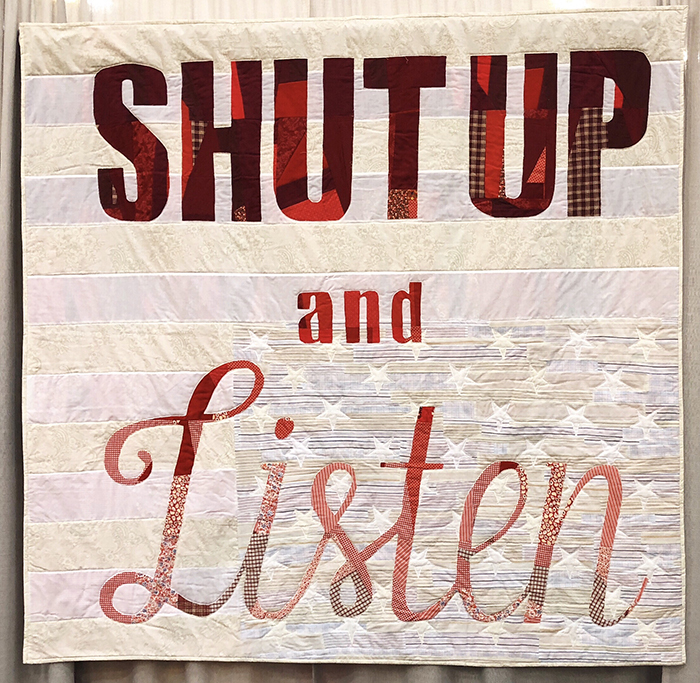Quilts on display at QuiltCon 2018 in Pasadena, California. At right is Shine A Light by Hillary Goodwin.
In 1976, the Museum of American Folk Art co-sponsored The Great Quilt Contest in collaboration with the U.S. Historical Society and “Good Housekeeping” magazine. Almost 10,000 quilts were entered in the contest to celebrate the American Bicentennial. The International Quilt Study and Museum describes that the quilts entered “reflect both patriotic fervor and constructive criticism of the government. As individuals and as groups, women chose quiltmaking for its symbolism as a women’s art form.”[1]
Using quilts as an art form to express political views is not new. In the 19th century, popular quilt block names include Lincoln’s Platform, President Polk in the White House, and Dewey’s Victory. As described on the QuiltIndex.org, the quilt Whig’s Defeat was a popular quilt pattern, and “is thought to have been a suffragist expression of a hoped for political outcome, expressed via needle and thread instead of the ballot box.”
Quilters have continued this tradition of using their voice, and their hands, to express themselves in clear and evocative ways. This was evident at last month’s QuiltCon, held in Pasadena, California. The annual event, organized by The Modern Quilt Guild (MQG), includes a juried quilt show with over 350 quilts on display. The juried quilt categories include handwork, improvisation, negative space, minimalist design, modern traditionalism, piecing, and more.
In 2018, the quilt show could have included an additional category: Statement Quilts. I spent several hours over the course of a few days walking through the quilt show, reading placards and studying quilts, including early in the morning before the show opened to the public. These statement quilts run the gamut, sharing personal mantras [I Am Enough], commentary on broad, far reaching institutions [Black, Brown, White, and Orange], personal and collective disbelief [Oh No], to suggesting a path forward [Shine the Light]. Neither the messages, nor the technical aspects of the quilts, including piecing styles and methods, shapes and colors, quilting and finishing details were similar from quilt to quilt. However, the collective strength of the messages ties the quilts together.
I Am Enough by Jessica Levitt
Get Woke by Chawne Kimber
Jessica Levitt’s bold I Am Enough quilt is an exercise in vulnerability. Jessica writes, “The path to more love and belonging in my life is to believe that I’m worthy of it, in all the many competing messages in my head, the one I want to be simple and clear is that I am enough, just as I am. This quilt isn’t perfect, but it is enough.”
Nearby, Darci Alexis Read’s stunning red, pink, and white quilt had a clear and simple message: “Women’s Rights Are Human Rights.” The quilt, located on an end cap, was easily seen by anyone walking around the outside of the exhibit. Chawne Kimber’s handwork quilt, Get Woke, created her Resist and Rise Up motif “in reaction to and encouragement of the current social awakening in the U.S.”
Detail of Reflection by Anne Sullivan
Black and Brown and White and Orange by Karen Maple
Some of the statement quilts were personal in nature. Anne Sullivan submitted a quilt in the Small Quilts category, titled Reflection. She writes, “Reflection was made to evoke reflected light on turbulent water and light growing from the darkness. 2017 was a turbulent year and this quilt is my self-reflection of the many things that have happened.”
In contrast, the artist statement for Black, Brown, and White in Orange, by Karen Maple, reads in part, “The United States incarcerates 3.5 times the number of people than European countries. African-Americans and Hispanics have much higher imprisonment rates than whites in the U.S.” Her quilt, which won a second place ribbon in the Appliqué category, was visually compelling, and almost demanded that show attendees stop to read her artist statement.

White America by Jessica Wohl

Shine A Light by Hillary Goodwin
Also in the Appliqué category, White America, by Jessica Wohl, calls into question the idea of whiteness in the United States. Jessica writes, “It may also be an eager reminder to consider and listen to the urgent needs of others, as an abrupt call for empathy desperately pleading for the recovery of our nation’s bifurcated and polarized state.” Jessica uses her art form, and the process of quilt making, to reinforce her point—the words on the quilt are created by reverse appliqué so that the “text cuts into the layer of white, like a skin revealing a blanket of red, a wound or bodily cut, addressing the physical trauma our country is enduring.”
There were a handful of makers whose quilts made statements about their reaction to the fractured U.S. political scene—Hillary Goodwin’s Shine A Light quilt and her design process were a personal call-to-action to be the good—an acknowledgement of the polarization of post-election America—and a reminder of “the powerful potential of our collective efforts” to do good in the world. When I spoke with Hillary, she said, “This quilt came from my heart. I felt depressed and conflicted about things that were hard for everyone to process,” and she felt that her anger was consuming her. She works closely with people with very different political views, and said, “I love them, and they love me. We can co-exist as good people with respect for each other and find ways to meet in the middle.” Hillary explained that the act of making this quilt was cathartic—“quilts that come from the heart have soul baked in”—and she uses the quilt and the quilt-making process to remind herself to leave some of that anger and get to work helping others with their very real needs.
At left is Strong Tradition by Allison Chamber
Allison Chamber’s quilt, Strong Tradition, had boldly pieced letters on a pink background that read, “Strong Women Taught Us to Quilt… and to Fight.” Allison reminds us, “Creating quilts as a call-to-action is nothing new. Women, confined to their “Sphere of Domesticity,” used their domestic tasks in subversive and powerful ways, creating quilts that reflected their views on politics or social issues. We wanted to honor the women who taught us to quilt, to fight and those who have used quilting to fight against injustices.”
The statement quilts, in addition to being striking, provocative, and thoughtful, were also technically-sound quilts. Some messages were overt, such as the quilts that employed text, and others were minimalist designs that you didn’t realize were statement quilts until you looked a little closer and read the artist’s statement. Even so, this genre of quilts represented a small percentage of the over 350 quilts juried in the show. The statement quilts’ effect on viewers, however, should not be understated.
Just before QuiltCon closed, a Modern Quilt Guild representative announced the Viewer’s Choice quilt over the loudspeaker, which attendees voted on using the conference’s smart phone app. Viewer’s Choice went to Liz Harvatine, creator of an incredible quilt that speaks for itself: “Nevertheless, She Persisted.”
Nevertheless She Persisted by Liz Harvatine
Other Statement Quilts
(certainly not an exhaustive list)
2 Degrees C by Stephanie Ruyle [Group or Bee Quilts]
Positive : Negative by Lorena Uriarte [Piecing]
Oh No by Diane Wespiser [Piecing]
America the Beautiful by Amy Guiam [youth category]
There is no planet B by the Niagara MQG [Charity Quilt]
Passage by Carson Converse [Minimalist Design]
We Must Try by Ashley Brown Durand [Minimalist Design]
Veer by Jacquie Gering [Minimalist Design]
Ms Conceived by Miriam Coffey [Use of Negative Space]
Further Reading: Janet Catherine Berlo, Feminism and Nationalism in the Construction of a Quilt Heritage in the United States in the 20th Century, http://www.quiltindex.org/essay.php?kid=3-98-22.
Current Exhibit [ends May 11, 2018], Quilts and Human Rights, Pick Museum of Anthropology, http://www.niu.edu/pick-museum/exhibits/index.shtml.

Katie Clark Blakesley
contributor
Katie is an author, quilter, and outdoor enthusiast who tries to balance her newfound love of the mountains with everything else. The author of Vintage Quilt Revival and co-founder of Pattern Drop—the only quilt pattern of the month club for creatives who love unique, premium patterns—Katie’s work can most often be found at http://swimbikequilt.com.

Thanks for this wonderful overview. I urge people who make political statement quilts to also consider posting them at http://www.unitedwequilt.com/. There are many more there to look at!